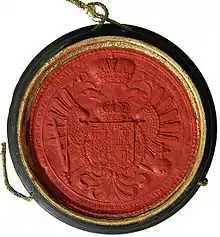André Falquet
André Falquet[1] (* February 11, 1681 in Geneva;[2] † January 28, 1755 ibid)[3] was a Geneva merchant and trader, and a member of the Council of Two Hundred.


Life
Falquet's paternal ancestors came from Pouilly (Contamine-sur-Arve). His great-great-grandfather Aymé Falquet was a vinegar manufacturer there. André Falquet's great-grandfather eventually acquired a property in Geneva. Falquet's father Pierre was a jeweler.
André Falqet was baptized on Monday, February 14, 1681, in Saint-Pierre Cathedral by Charles Dufour. The godfather was André Rousseau, the brother of David Rousseau, Jean-Jacques' grandfather.[4]
Falquet worked in his father's business (jewelry trade) from the completion of his studies (1703). In 1703 he traveled through Southern Germany. While there, he became involved in the turmoil of the War of the Spanish Succession and, since he spoke French, was able to plead with the French Marshal de Villars for the release of four confiscated wagons with merchandise belonging to Augsburg merchants. For this he received from the city of Augsburg a silver-gilt cup, the Gobelet André Falquet. For the services rendered to the Imperial Austrian Army (trade transactions), Falquet was ennobled and his coat of arms was improved by the Nobilization Certificate of June 16, 1725.
André Falquet married Suzanne Lullin on June 10, 1731.
From 1734 Falquet was a member of the Geneva Council of Two Hundred.
Nobility Diploma
In 1725 he was ennobled by a document of Charles VI and his coat of arms was improved. The document contains thirteen inscribed parchment pages, of which the depiction of the coat of arms fills an entire page. The entirety of the document is written in Latin, since the chancery regulations did not allow the use of French – André's native language – but prescribed the use of German or Latin. The document is signed and witnessed several times, as required by letters of nobility and arms of the Imperial Court Chancellery, namely by
- Charles IV;
- Friedrich Karl Graf von Schönborn, the Imperial Vice-Chancellor;
- Philipp Wilderich Johann Georgendiel von Georgenthal, the "secret secretary and referendary of Latin expedition" of the Imperial Court Chancellery;
- Jodoc Pein, the Registrar of the Imperial Court Chancellery.
The seal of Charles VI is also attached to the letter.
Family
Some of his descendants, Jean-Louis Falquet, were again statesmen.
See also
Literature
- Archives Héraldiques de la Suisse, Bd. XXXII (1918), S. 24.
- Anzeiger für Schweizerische Altertumskunde, Zürich. Jg. 25 (1892).
- J. Haller & S. Brügger: Adelsbrief André Falquet. Aspekte einer kaiserlichen Urkunde von 1725, Aarau 2007 (Maturaarbeit).
- Gustave Chaix d'Est-Ange: Dictionnaire des familles françaises anciennes ou notables à la fin du XIXe siècle: Fab-For, Éditions Vendôme, 1983, S. 82 ff., (gallica.bnf.fr: Full view), (Google Books: snippet view).
- C.F. Lendorff: Almanach généalogique suisse, Band 4, 1913, S. 192, (archive.org: Full view), (Google Books: snippet view).
- J.-A.Galiffe: Notices généalogiques sur les familles genevoises, depuis les premiers temps, jusqu'à nos jours, Genève, 1831, S. 250 Googlebooks
- Vermerk über den Taufpaten André Rousseau in Rosenblatt, H.: Rousseau and Geneva: From the First Discourse to the Social Contract, 1749–1762, 1997, Cambridge University Press, ISBN 0-521-57004-2, Seite 31, Fussnote 99, Googlebooks.
- CH AVG (Archives de la Ville de Genève): Factums judiciaires, Band 2, Nummer 14 und 14bis.
Website links
References
- Haller, J. & Brügger, S.: Adelsbrief André Falquet - Aspekte einer kaiserlichen Urkunde von 1725. Aarau, 2007.
- Entrée pour André Falquet dans le registre de la paroisse protestante de Saint-Pierre avec l'Auditoire: 1) Baptêmes du 1er janvier 1678 au 14 avril 1699. Archive de l'Etat de Genève, «CH AEG E.C. Saint-Pierre B.M. 10», Photo of the record.
- Société généalogique de Genève: André Falquet (1681–1755), (ancestors and descendants)
- Rosenblatt, Helena (1997). Rousseau and Geneva: From the First Discourse to The Social Contract, 1749–1762. Ideas in Context. Cambridge University Press. pp. 31, footnote 99. ISBN 0-521-57004-2.
